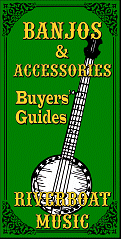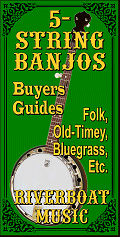

|
| Please Read: How to Help Our Site at No Cost to You - Some of our articles contain recommendations for products we like and vendors we personally trust. Some of those vendors may pay us a very small commission if you click on a link and buy their products. This costs you nothing at all and helps offset the costs of what we do. So if we point you to something you decide to buy later, please make certain you come back through our site and click on the link directly. Thanks.
|
| This Site is a Cookie-Free Zone - Except for discussion forums that you have to expressly register for, none of our pages use cookies of any kind. Some of the vendors we link to do, but that won't affect you unless you click on a link to their pages. Your continued use of this page indicates that you agree to our policy. For details, click here.
|
Free 5-String Banjo Tabulature and Instructions
Written by Paul Race for Creek Don't RiseTM
This page is going to provide links to free tabulature and instructional resources for the 5-string banjo, in all of its major iterations. Some will be things we've created; some will be links to things we've found on other web pages that should be useful.
 About Tabulature for 5-String Banjo About Tabulature for 5-String Banjo
Most banjo training resources use something called "Tab," short for "Tabulature." The lines on a tab each represent a string on the instrument. Little numbers on the lines show which strings you play on that beat and which fret, if any, you finger with your left hand.
To me, tabulature does not replace having the music written out. After all, there are many ways to play most notes on a banjo, and I may prefer one of the other ways to play. But once you get used to tabs, you'll pick up simple parts quickly.
As you've probably learned up by now, the five-string banjo has four strings you may or may not fret, and one string you usually don't. If your banjo is tuned to the most common tuning, and you lay it in your lap and start with the farthest string out, the notes are D, the B below that, the G below that, the D below that, and, finally, a G that's higher than the the first string. In fact, if you fret the first string at the fifth fret, it's usually the same as the fifth string unfretted.
 When you see a number, that means that you are to play that string with it fretted at that fret. If you don't actually fret a string at all, the number is zero, like it is in the illustration above. In the illustration to your right, the number "1" on the second string means that you put your finger down just behind the first fret on the second string, holding the string hard enough that it doesn't buzz. If you look at the music staff above, you'll see that you're playing a "C" note. The "D" note that's crammed onto the same staff is the first string, which is open (not fretted). The fact that the numbers are stacked on top of each other on the fret lines means that you play them both at once. Again, the music staff above gives those of you who read a little music a sense of what the rhythm should be. When you see a number, that means that you are to play that string with it fretted at that fret. If you don't actually fret a string at all, the number is zero, like it is in the illustration above. In the illustration to your right, the number "1" on the second string means that you put your finger down just behind the first fret on the second string, holding the string hard enough that it doesn't buzz. If you look at the music staff above, you'll see that you're playing a "C" note. The "D" note that's crammed onto the same staff is the first string, which is open (not fretted). The fact that the numbers are stacked on top of each other on the fret lines means that you play them both at once. Again, the music staff above gives those of you who read a little music a sense of what the rhythm should be.
Tabs and Right-Hand Technique
You may have gathered that there are any number of ways to allocate your right-hand fingers to pick certain strings or to play on certain beats or both. Folks who write banjo books often indicate which finger you should use by sticking little letters under the staff. That said, I'm not going to lay awake nights worrying about whether you play a specific note with your thumb, your forefinger, or the back of your index finger nail. In fact, if you are working with simple songs like "Boil that Cabbage Down," you'll discover that the tabulature for every style of picking is essentially the same, with one exception - 3-finger "Scruggs" pickers don't play as many of the strings on the "upbeat" as people who strum that beat. But the critical notes are almost always all the same.
In other words, the tab is a guideline to help you learn a tune, and once you have the general idea, the rest is quite up to you. Outside of playing it with an axe, there really isn't any way to play the banjo wrong, despite a certain class of whiners who will complain that you don't do it exactly the same way they do.

Resources So Far
We have a number of other projects in the pipeline, and we're trying to get permission to link to additional resources, but these may help get you started:
- Setting Up 5-String Banjo - How to make certain your banjo is ready to play so you have a fighting chance at making good use of the rest of these articles.
- For some basic instructions, and accompaniments for a few simple songs, check out our articles on Beginning 5-String Folk Banjo. Actually, if you remember banjo mostly as a Folk instrument in the late 1950s and early 1960s, this may be the place you want to start.
- In the interest of meeting the needs of Bluegrass players, I'm also attempting to rescue, restore, and repost the free online lessons of Mitchell "Mickey" Cochran, originally published in 1999-2004. To see how far I've got so far, please click here
- We've also reposted the Clawhammer Reference and Tablature Files originally created and posted by by "Tom Joad" (A.K.A. Chris Erswell) here. If you don't play Clawhammer, don't fret, many of these files can be played with other styles of picking.
- If you already play Bluegrass and would like to learn at least the basics of Clawhammer, Bob Flesher wrote a brief introduction called "Bluegrass Pickers Can Learn Clawhammer."
- If you want experiment with a number of different Bluegrass banjo rolls, check out the Elfshot Banjo Rolls page.
- "You Can't Take the Sky From Me" - A fellow science fiction buff who learned I was trying to figure out how to play a certain Joss Whedon television show theme song on the banjo had pity on me and sent me a transcription of the violin/banjo solo as well as a suggested roll to "flesh" the whole thing out. I'll leave his tabs posted until the Alliance lets me know they don't want them here any more. To give it a try yourself, click here.
Choosing a Banjo - If you don't have a banjo already, here are some articles that might help you choose the best one for your present needs.
The web is turning into a great place for keeping musical traditions alive. Many folks have spent many hours trying to share their own "lessons learned." If you're finding our resources or those we link to helpful, the best thing you can do is to learn what you can and pass on what you learn.
Return to our Tabs and Instructions index page.
Please get in touch.if you have found a resource you'd like us to add, if you'd like to ask questions, or if you'd like to sign up for our newsletter.
 Whatever else you get out of our pages, I hope you enjoy your music and figure out how to make enjoyable music for those around you as well. Whatever else you get out of our pages, I hope you enjoy your music and figure out how to make enjoyable music for those around you as well.
And please stay in touch!
- Paul Race









|
|
All material, illustrations, and content of this web site is copyrighted ? 2001, 2002, 2003, 2004, 2005, 2006,
2007, 2008, 2009, 2010, 2011, 2012, 2013, 2014, 2015 by Paul D. Race. All rights reserved.
Creek Dont' Rise(tm) is a participant in the Amazon Services LLC Associates Program, an affiliate advertising
program designed to provide a means for sites to earn advertising fees by advertising and linking to Amazon.com.
For questions, comments, suggestions, trouble reports, etc. about this play or about this web page, please
contact us.
| Visit related pages and affiliated sites: |
| - Music - |

|
 |
 |

|

|

|

|

|

|

|

|

|

|

|

|

|

|

|
| - Trains and Hobbies - |

|

|

|  |
 |

|
| - Christmas Memories and Collectibles - |
 |

|
 |

|
 |

|
| - Family Activities and Crafts - |
 |

|

|

|

|

|
|





 When you see a number, that means that you are to play that string with it fretted at that fret. If you don't actually fret a string at all, the number is zero, like it is in the illustration above. In the illustration to your right, the number "1" on the second string means that you put your finger down just behind the first fret on the second string, holding the string hard enough that it doesn't buzz. If you look at the music staff above, you'll see that you're playing a "C" note. The "D" note that's crammed onto the same staff is the first string, which is open (not fretted). The fact that the numbers are stacked on top of each other on the fret lines means that you play them both at once. Again, the music staff above gives those of you who read a little music a sense of what the rhythm should be.
When you see a number, that means that you are to play that string with it fretted at that fret. If you don't actually fret a string at all, the number is zero, like it is in the illustration above. In the illustration to your right, the number "1" on the second string means that you put your finger down just behind the first fret on the second string, holding the string hard enough that it doesn't buzz. If you look at the music staff above, you'll see that you're playing a "C" note. The "D" note that's crammed onto the same staff is the first string, which is open (not fretted). The fact that the numbers are stacked on top of each other on the fret lines means that you play them both at once. Again, the music staff above gives those of you who read a little music a sense of what the rhythm should be.







































